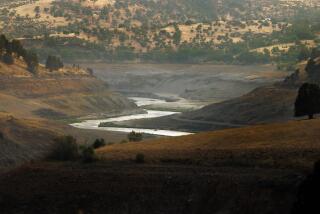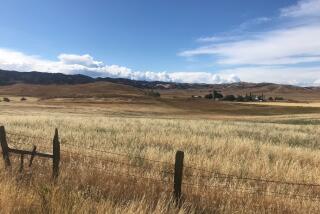China Puts Its Dam Project on a Firm Course
SANDOUPING, China — Amid the din of celebratory riverboat whistles, exploding firecrackers, patriotic anthems and the husky roar of trucks laden with massive boulders, China on Saturday took a major step toward realizing a 70-year-old dream, blocking the main channel of the mighty Yangtze River to permit final construction of the world’s biggest hydroelectric dam.
When the 600-foot-high Three Gorges Dam is completed in 2009 at an estimated cost of $29 billion, it will produce eight times as much electricity as Egypt’s Aswan Dam and will be five times wider than America’s Hoover Dam.
But the Three Gorges Dam--named for the spectacular series of three limestone-rimmed canyons that will be largely submerged by the dam’s reservoir--will also displace at least 1.2 million people and, critics contend, pose massive environmental and safety problems for one of the world’s most densely populated regions.
In the latest of six petitions he has sent to the Chinese leadership, prominent hydrologist Huang Wanli, 86, a professor emeritus at Qinghua University who worked on many of the country’s major hydroelectric projects, warned that the dam will cause massive death and destruction in upstream areas of Sichuan province.
“All Sichuan people are against building this reservoir,” Huang said in an interview with the Hong Kong-based South China Morning Post. “It will kill 500,000 people in the areas upstream, not in the reservoir area.”
Huang said the deaths will be caused by flooding produced when tributaries of the upper Yangtze, clogged with 100 million tons of cobblestones and sand that would previously have been flushed away by the swift-moving water, back up and swamp the densely populated area around the city of Chongqing.
Government engineers counter that the dam will solve the problem of flooding on the lower Yangtze, provide much-needed electric power to the river basin--home to 40% of the country’s industries--and allow oceangoing ships to travel deep into central Sichuan province, making Chongqing a seaport. They contend that environmental concerns have been thoroughly studied and debated.
No other waterworks project in history has forced the resettlement of so many people. When the 600-square-mile reservoir reaches its full capacity, it will submerge 13 cities as well as 1,392 towns and villages.
So far, only 92,000 people, mostly volunteers from low-lying areas, have been resettled. Many complain that they have not been able to find jobs in their new locations and that the government has not made good on its promise of financial support.
“The relocated people share the feeling that they cannot adapt to their new environments,” said Jiang Xuiqing, 34, an orange farmer who moved last year from his former home in the threatened Three Gorges reservoir area to another village in Hubei province below the dam site. So far, Jiang said, he has not been able to find full-time work. His wife’s attempt to produce a green bean crop failed when she bought the wrong type of seed. The couple said they spent more than $2,000 of their own money to build a new home.
Qu Jiayun, 37, said that before the dam project, she lived with her family on a tiny island that was in the center of the dam site. After construction began in 1994, she was relocated to a new home in the hills above project.
“I used to make pretty good money selling fruit to the tourists who came to see the Three Gorges,” said Qu, a cheerful woman who was trying to sell a single pomelo to construction workers and onlookers at the site. “Now I have no money, and I can’t even get a job.”
Chinese President Jiang Zemin, speaking here Saturday after U.S.-made dump trucks and bulldozers filled in the last gap in the temporary dam spanning the main channel, acknowledged both the resettlement and environmental problems faced by the project.
“Successful resettlement of the people affected by the Three Gorges project is key to its eventual success,” Jiang said. “The arduous and meticulous work involves the interests of millions of people.”
But the main theme sounded by the Chinese leader, fresh from what is viewed here as a triumphant state visit to the United States, was one of pride and nationalism. In the decades since it was first proposed by the late Nationalist leader Sun Yat-sen in consultation with American engineers, building a major dam in the Three Gorges area has become a powerful symbol of resurgent national might.
Although faced with substantial opposition by international environmental groups and the reluctance of foreign government banks to participate in funding for the controversial dam because of environmental concerns, China’s Communist leadership has stubbornly and successfully bulldozed ahead with the project.
Construction on the dam began in December 1994 when workers dug a diversion canal on the southern bank of the river that will handle river flow and ship traffic until the dam is completed.
The next challenge for engineers here is to complete the main foundation--using the temporary dam as a shield from the river waters--for the new dam before the snows melt in Tibet next May and raise the river to its highest level.
In Saturday’s elaborate “river closure ceremony”--broadcast nonstop for 14 hours on China Central Television--the leadership made it clear that it intends to see the project through.
“The age-old dream of the Chinese people to develop and utilize the resources of the Three Gorges of the Yangtze River is closer to becoming true,” Jiang said. “This proves vividly once again that socialism is capable of concentrating resources to do big jobs.”
In the days leading up to Saturday’s ceremony, officials spoke constantly of the project as “proof” of China’s greatness and capability to tackle major projects. Yet it is precisely this capability that has been the focus of the dam’s outspoken critics, many of whom continue to voice opposition in the face of a government that has little tolerance for dissent.
Critics point to China’s poor track record in dam safety, citing the cases of two much smaller dams in Henan province that collapsed during flooding in 1975, reportedly killing between 30,000 and 230,000 people. The Chinese government has never officially acknowledged the dam failures, but details have surfaced in several reports smuggled out of China by environmental and human rights organizations.
Foremost among the Three Gorges critics is engineer-journalist Dai Qing, an outspoken woman who spent 10 months in Chinese prisons under a death sentence for her opposition to the Yangtze dam. In addition to voicing concerns over safety and environmental aspects of the dam, Dai says the Three Gorges project represents an egomaniacal revival of the giant, ill-advised projects that marked the Maoist period of 1949-76.
“The Three Gorges is not a hydroelectric project,” said Dai, a former rocket scientist who is the daughter of a revolutionary army general. “It is a political project exhibiting all the characteristics of a centrally controlled socialist economic system. It is the product of a system of dictatorship--a one-party system. It is a central government decision that all provinces in China must support.
“There is no freedom to express opposition to this project in China,” she said. “All these characteristics are meant to show how strong the Chinese Communist system really is.”
Evidence of the monumental political stakes involved was on full display Saturday. Both Jiang and Premier Li Peng, a longtime champion of the project, presided over the rites. A hillside above the dam site was decked with green carpet bearing giant white Chinese characters lauding the project. A navy band played patriotic music.
After Jiang delivered his speech, the president and the premier, who are both Soviet-trained engineers, descended from the podium and stood among a crowd of weeping, adulatory workers on the granite temporary dam in what was once the center of the river’s main channel.
The principal message conveyed by the leadership was that the Three Gorges project had reached the point of no return. Much work remains to be completed but, despite the massive cost and significant opposition, the dam will be built.
“We have proved to everyone that China has the capability to build the largest hydroelectric project in the world,” said dam official Guo Shuyan.
(BEGIN TEXT OF INFOBOX / INFOGRAPHIC)
Damming the Yangtze
The proposal to build a major dam in the Three Gorges area was first conceived by the late nationalist Chinese leader Sun Yat-sen in consultation with American engineers. Making the 70-year-old dream a reality will:
* Cost an estimated $29 billion.
* Displace 1.2 million people.
* Submerge 13 cities as well as 1,392 towns and villages.
* Allow China to generate 18,200 megawatts of electrity.
* Allow oceangoing ships to travel deep into central Sichuan province on the Yangtze.
****
The Project Will:
* Use 26 million tons of concrete
* Use 250,000 tons of steel
* Employ 20,000 people
Researched by RONE TEMPEST / Los Angeles Times
More to Read
Sign up for Essential California
The most important California stories and recommendations in your inbox every morning.
You may occasionally receive promotional content from the Los Angeles Times.










